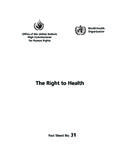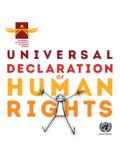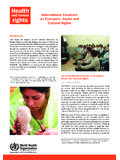Transcription of THE RIGHT TO HEALTH - WHO | World Health …
1 "The RIGHT to HEALTH can be understood as the RIGHT to an effective and integrated HEALTH system encompassing HEALTH care and the underlying determinants of HEALTH , which is responsive to national and local priorities, and accessible to all. Underpinned by the RIGHT to HEALTH , an effective HEALTH system is a core social institution, no less than a court system or a political system." The United Nations Special Rapporteur on the RIGHT of everyone to the enjoyment of the highest attainable standard of physical and mental HEALTH (2006).
2 JOINT FACT SHEET WHO/OHCHR/323 AUGUST 2007 THE RIGHT TO HEALTH The RIGHT to HEALTH means that governments must generate conditions in which everyone can be as healthy as possible. Such conditions range from ensuring availability of HEALTH services, healthy and safe working conditions, adequate housing and nutritious food. The RIGHT to HEALTH does not mean the RIGHT to be healthy. The RIGHT to HEALTH has been enshrined in numerous international and regional human rights treaties as well as national constitutions all over the World .
3 Examples of UN human rights treaties: International Covenant on Economic, Social and Cultural rights (ICESCR), 1966 Convention on the Elimination of All Forms of Discrimination Against Women (CEDAW), 1979 Convention on the rights of the Child (CRC), 1989 Examples of regional human rights treaties: European Social Charter, 1961 African Charter on Human and Peoples rights , 1981 Additional Protocol to the American Convention on Human rights in the Area of Economic, Social and Cultural rights (the Protocol of San Salvador), 1988.
4 The International Covenant on Economic, Social and Cultural rights (1966) in Article 12 states that steps for the realization of the RIGHT to HEALTH include those that: 9 reduce infant mortality and ensure the healthy development of the child; 9 improve environmental and industrial hygiene; 9 prevent, treat and control epidemic, endemic, occupational and other diseases; 9 create conditions to ensure access to HEALTH care for all. To clarify and operationalize the above provisions, the UN Committee on Economic, Social and Cultural rights which monitors compliance with the ICESCR adopted a General Comment on the RIGHT to HEALTH in 2000.
5 The General Comment sets out that the RIGHT to HEALTH extends not only to timely and appropriate HEALTH care but also to the underlying determinants of HEALTH , such as access to safe and potable water and adequate sanitation, an adequate supply of safe food, nutrition and housing, healthy occupational and environmental conditions and access to HEALTH -related education and information, including on sexual and reproductive HEALTH .
6 FACT SHEET The enjoyment of the highest attainable standard of HEALTH is one of the fundamental rights of every human being without the distinction of race, religion, political belief, economic or social condition. (WHO Constitution) Everyone has the RIGHT to a standard of living adequate for the HEALTH and well-being of himself and of his family, including .. medical care and necessary social services. (Article 25 (1) Universal Declaration of Human rights ) Joint Fact Sheet WHO/OHCHR/323 Page 2 According to the General Comment the RIGHT to HEALTH contains four elements: Availability.
7 Functioning public HEALTH and HEALTH care facilities, goods and services, as well as programmes in sufficient quantity. Accessibility. HEALTH facilities, goods and services accessible to everyone, within the jurisdiction of the State party. Accessibility has four overlapping dimensions: 9 non-discrimination, 9 physical accessibility, 9 economical accessibility (affordability), 9 information accessibility. Acceptability: All HEALTH facilities, goods and services must be respectful of medical ethics and culturally appropriate, as well as sensitive to gender and life-cycle requirements.
8 Quality: HEALTH facilities, goods and services must be scientifically and medically appropriate and of good quality. The RIGHT to HEALTH , like all human rights , imposes on the State Party 3 types of The RIGHT to HEALTH HEALTH -careUnderlying determinantswater, sanitation, food, nutrition, housing, healthy occupational and environmental conditions, education, information, , Accessibility, Acceptability, Quality(General Comment No. 14 of the Committee on Economic, Social andCultural rights )obligations: Respect: This means simply not to interfere with the enjoyment of the RIGHT to HEALTH .
9 Protect: This means ensuring that third parties (non-state actors) do not infringe upon the enjoyment of the RIGHT to HEALTH . Fulfil: This means taking positive steps to realize the RIGHT to HEALTH . According to the General Comment, the RIGHT to HEALTH also has a "core content" referring to the minimum essential level of the RIGHT . Although this level cannot be determined in the abstract as it is a national task, key elements are set out to guide the priority setting process.
10 Essential primary HEALTH care; minimum essential and nutritious food; sanitation; safe and potable water; and essential drugs are included in the core content. Another core obligation is the adoption and implementation of a national public HEALTH strategy and plan of action. This must address the HEALTH concerns of the whole population; be devised, and periodically reviewed, on the basis of a participatory and transparent process; contain indicators and benchmarks by which progress can be closely monitored; and give particular attention to all vulnerable or marginalized groups.

















